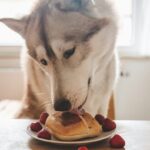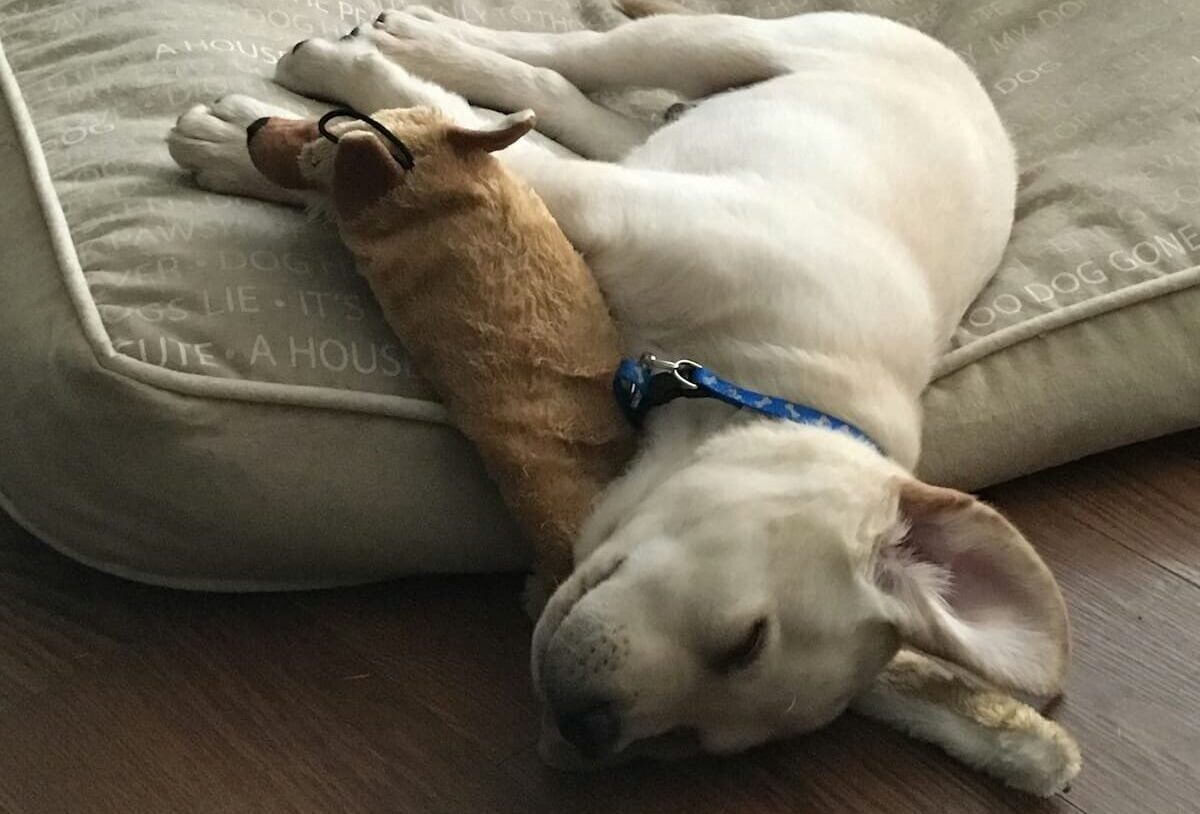Have you ever noticed your furry companion’s eyes rolling back while they doze off?
It’s almost like they’re entering a mysterious, dreamy realm, leaving you pondering the intriguing question: ”Why do dogs’ eyes roll back when they sleep?”
This article will answer your question.
The Science Behind Dogs’ Eye Movements During Sleep
Dogs are fascinating creatures, and one peculiar behavior they exhibit while sleeping is the rolling back of their eyes.
This phenomenon has left many pet parents puzzled and wondering why it happens.
But fear not, for there is are scientific reasons behind this fascinating phenomenon.
Firstly, it’s important to note that dogs have a different sleep pattern compared to humans.
During their slumber, dogs enter different sleep stages, including REM (Rapid Eye Movement) sleep.
This REM sleep stage is when most of their dreaming occurs, accompanied by various bodily movements and even vocalizations.
As their dreams become more vivid, their eyes may roll back as a result of the intense brain activity happening behind those adorable eyelids.
Secondly, rolling eyes during sleep is not exclusive to dogs, as many other mammals, including humans, experience this too.
It’s simply a result of the fascinating way our brains function while we sleep.
So, next time you catch your furry friend in this peculiar state, remember that they are simply embarking on an adventure inside their subconscious mind.
Understanding the Different Stages of Canine Sleep
To understand why dogs’ eyes roll back when they sleep, we need to dive into the different stages of canine sleep and how their bodies react during each stage.
Stage 1: NREM Sleep - In the first stage of sleep, known as non-rapid eye movement (NREM) sleep, dogs transition from wakefulness to a relaxed state.
During this stage, their eyes may roll back slightly, as they start to feel drowsy and their muscles begin to relax.
You’ll notice their breathing slowing down and becoming more regular as they enter a light sleep.
This stage is typically brief and lasts for only a few minutes.
Stage 2: REM Sleep – The second stage of canine sleep is rapid eye movement (REM) sleep, which is when dogs are in their deepest slumber.
It is during this stage that most dreams and vivid sleep movements occur.
While their eyes may intermittently flicker under their closed eyelids, the phenomenon of their eyes rolling back happens due to the relaxation of certain muscles around the eyes and face.
It’s important to note that during REM sleep, a dog’s brain activity is actually similar to that of a waking dog, indicating that they are actively dreaming.
During REM sleep, other fascinating things occur as well.
Dogs’ breathing becomes irregular, and their heart rate and blood pressure fluctuate.
Additionally, their leg muscles may twitch, leading us to believe that they may be acting out their dreams.
It’s truly a spectacle to witness, not to mention how adorable they look with their eyes rolling back and paws moving about!
Common Sleep Positions and Eye Movements in Dogs
While observing your furry pal drifting off into dreamland, you might notice a few common sleep positions they adopt.
Each position holds unique significance when it comes to their rest and well-being.
Some popular sleep positions in dogs include:
The Curled Up Position: This is when your dog curls up with their tail neatly tucked under their body, resembling a cozy ball.
Dogs often assume this position to conserve body heat and provide a sense of security, mimicking how they slept in dens in the wild.
The Stomach Position: Many dogs also enjoy sleeping on their stomachs with their paws tucked neatly under their bodies.
This position allows for quick action in case they need to spring into action, making them feel protected and ready to go.
The Side Position: Dogs who sleep on their sides, with their legs extended or slightly bent, are often in a deep and comfortable slumber.
This position helps them regulate body temperature better and is usually seen in dogs who feel secure in their environment.
Promoting Healthy Eye Movements in Your Dog’s Sleep Environment
To ensure that your dog’s sleep environment promotes healthy eye movements, there are a few things you can do.
Firstly, make sure your pup has a comfortable and cozy bed.
Providing them with a supportive mattress or pillow will help them get a good night’s sleep.
You can also consider using a fan or white noise machine to create a soothing environment, as this can aid in deeper sleep and promote healthy eye movements.
Another important aspect is to ensure that the area where your dog sleeps is dimly lit or even completely dark.
Just like us, dogs need a conducive environment for their sleep.
Reducing any sources of bright light can help your pup fall asleep faster and experience better REM sleep.
You can simply close the blinds or curtains, or even invest in sleep masks made specifically for dogs if necessary.
In conclusion, observing your dog’s eyes rolling back when they sleep is not something to worry about.
It’s a natural part of their sleep cycle and indicates that their brain is actively engaged in processing dreams.
By providing a comfortable and soothing sleep environment, you can help ensure that your beloved pet experiences healthy eye movements during their slumber.
So go ahead, create a peaceful sanctuary for your furry friend to rest and dream away!
FAQ
Q: Why do dogs’ eyes roll back when they sleep?
A: Ah, the rolling eyes of snoozing canines!
It’s actually a completely normal and harmless occurrence.
When dogs fall into a deep sleep, their eyes tend to move underneath their lids, causing them to roll back or even flutter a bit.
Q: Is there a scientific explanation for this behavior?
A: Yes, indeed!
According to veterinary experts, dogs go through different stages of sleep, just like us humans do.
During REM (rapid eye movement) sleep, which is the stage closest to wakefulness, dogs experience heightened brain activity.
As a result, their eyes may dart around beneath their closed eyelids, making them twitch, roll, or move.
Q: What happens during this REM sleep stage?
A: Well, during the REM stage, several intriguing things happen to your furry buddy.
It’s when their brain becomes highly active, their muscles relax, and their dreaming adventures begin.
You might notice your dog’s paws twitching, their tail wagging, or even hear soft barks escaping their lips.
It’s a fascinating phase of slumber, often accompanied by those mesmerizing rolling eyes!
Q: Does this sleeping behavior indicate any health concerns?
A: Don’t worry, it’s typically nothing to be concerned about!
Eye rolling during sleep is considered quite natural for dogs. It’s a sign that they’re happily and deeply immersed in their dreams.
However, if you notice any unusual eye movements while your pup is awake, such as rolling or constant twitching, it’s always a good idea to consult your veterinarian to rule out any possible health issues.
Q: Can dreaming be the reason behind these eye movements?
A: Absolutely!
Just like us, dogs are believed to dream during REM sleep.
Their eyes are probably following the images, scents, or exciting scenarios they encounter in their dreams.
So, next time you see your furry friend’s eyes rolling back, you can smile, knowing they’re off on an adventure in dreamland!
Q: Should I wake my dog up when I see their eyes rolling back?
A: It’s generally recommended to let sleeping dogs lie!
Interrupting their sleep, especially during REM or deep sleep, might disrupt their natural sleep cycle.
Just like us, they need their restorative slumber to recharge and maintain a healthy lifestyle.
So be patient and resist the temptation to wake them, unless it’s absolutely necessary.
Q: Can I comfort my dog if I think they’re having a nightmare?
A: Of course!
If you suspect your dog is having a nightmare, gently waking them up with a soft voice or a gentle touch can provide reassurance.
Offer them some comforting words and cuddles to make them feel secure.
Remember, a little extra love is always beneficial for our furry friends.
Q: Can different dog breeds exhibit various eye movements while sleeping?
A: Absolutely!
Dogs come in all shapes, sizes, and breeds, and their sleeping habits can vary too.
Some may have more noticeable eye rolling or movement, while others might not roll their eyes much at all.
It’s simply a unique trait, much like human individualities.
Q: In summary, why do dogs’ eyes roll back when they sleep?
A: In a nutshell, when dogs enter deep sleep or REM sleep, their eyes may start moving rapidly beneath their closed eyelids, causing them to roll back or flutter.
It’s an entirely natural behavior and is often associated with their adventurous dreams.
So, the next time you catch your four-legged friend with their eyes in the back of their head, cherish the amusing sight and know that they’re experiencing their own little slumber escapade!
Farewell Note
It turns out there’s no mystical force at play, but rather a simple explanation rooted in their biology.
We discovered that this backward eye movement during sleep is perfectly normal and takes place due to an adorable reflex called the ‘REM’ or Rapid Eye Movement phase.
Just like us humans, dogs experience different stages of sleep, and during REM, their eyes start to dart around underneath their eyelids.
While witnessing our canine companions’ eyes roll back may initially seem odd or even a bit spooky, it’s important to remember that it’s completely harmless and a sign that they’re enjoying a restful slumber.
So the next time you catch your pup snoozing soundly with their eyes in the back of their head, rest assured that they’re experiencing a pawsitively perfect sleep cycle!














